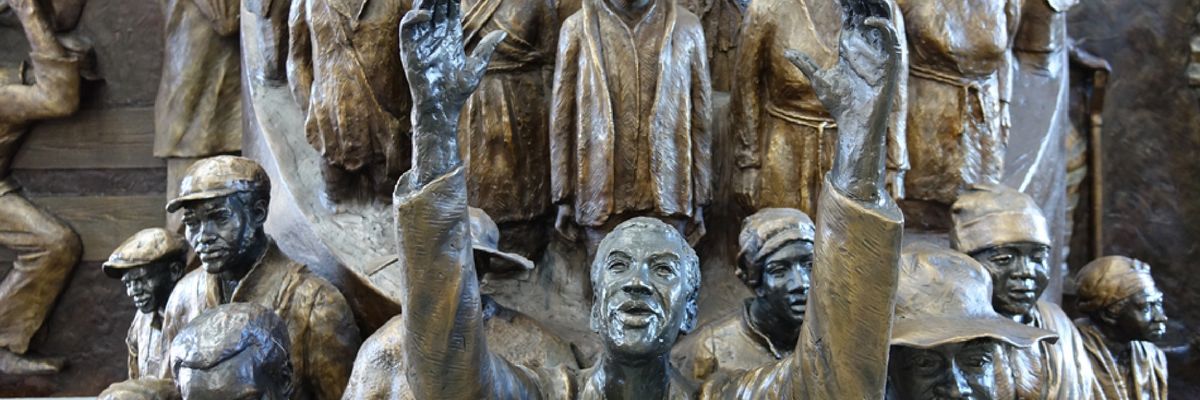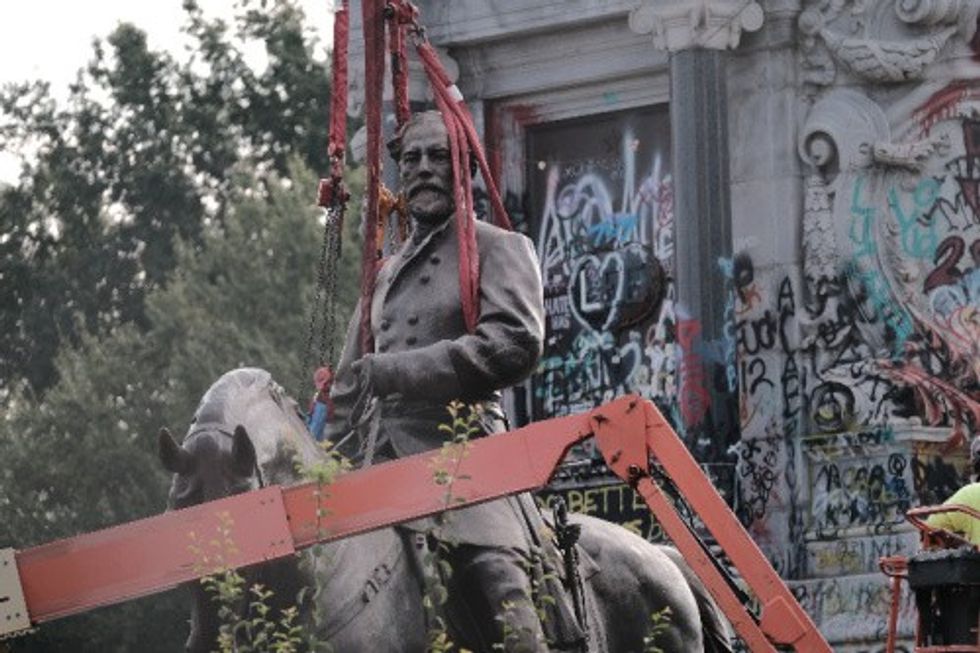Aptly for a nation built on racism, Juneteenth marks not the actual day enslaved black Texans were declared free but the day Union troops bothered to tell them they were free - months after the Civil War ended, and two years after Lincoln's Emancipation Proclamation. Today, black Americans beset by newly bold white supremacy, from the erasure of their history to the erosion of their voting rights, fight back with rage, truth, art, protest, but are still moved to ask: "How long must we sing this song?"
The new, nationally recognized holiday of Juneteenth, often dubbed Freedom Day, commemorates June 19th, 1865, the day Major General Gordon Granger arrived in Galveston, Texas with 1,800 Bluecoats to inform enslaved African-Americans that they, and all other slaves, were free by executive decree. On April 9 of that year, General Robert E. Lee had surrendered his Army of Northern Virginia to General Ulysses S. Grant; on January 1, 1863, two-and-a half years earlier, President Lincoln had signed an Emancipation Proclamation ending slavery (at least on paper) for over 3 million blacks in Confederate states and proclaiming those formerly enslaved "shall be then, thenceforward, and forever free, and that the Executive Government of the United States (will) recognize and maintain the freedom of such persons.” Still, magic wands have long been scarce: Granger's General Order Number 3 asserted "an absolute equality of personal rights" between black and white, but it also warned, "Freedmen are advised to remain quietly at their present homes and work for wages. They will not be allowed to collect at military posts (and) will not be supported in idleness either there or elsewhere.”
In truth, change was slow then as now, and often ugly. Despite the fact that Black Americans had long suffered in singularly ghastly ways, and picked cotton to fund the war economy, and fought for the U.S. - in the two years since Emancipation, roughly 200,000 black men had enlisted - those determined to preserve white supremacy continued to oppress, terrorize and sometimes kill now-uppity slaves threatening to change their world. "The war may not have brought a great deal of bloodshed to Texas,” notes historian Elizabeth Hayes Turner, “but the peace certainly did." In 1865, Texas newspapers still advertised slaves for sale; once-Confederate legislators passed Black Codes that bound Blacks to year-long contracts in the fields, prohibited them from meeting in groups or owning property; white "slave patrols" hunted down runaway blacks they beat, tortured, lynched. One former slave testified, "You could see lots of niggers hangin’ to trees right after freedom, ’cause they cotch ’em swimmin’ ‘cross Sabine River and shoot ’em." Some slaves unknowingly remained in bondage long after Emancipation; said former slave Katie Darling, who worked for her mistress another six years, "She ‘whip me after the war jist like she did ‘fore."
Many narratives emerged from a New Deal writers’ project during the Depression; one historian interviewed “Tempie” Cummins at her weather-beaten home in Jasper, Texas. Cummins, who didn't know her age, found out as a child she'd been freed when her mother, a cook for their master's family, overheard him at dinner say he planned to keep the news secret until his slaves harvested "another crop or two." Her mother slipped outside, cracked her heels together four times and shouted, "I's free, I's free." Then "she runs to the field ‘gainst marster’s will and tol’ all the other slaves and they quit work.” Like slaves kept pointedly illiterate, such cruel deception was a longtime practice both here and abroad. A recent exhibit at D.C.'s Museum of the Bible featured a rare Bible from the early 1800s used by missionaries to convert African slaves in what was then British West Indies. It excludes any content that might inspire rebellion or liberation, eliminating 90% of the Old Testament and half of the New - with just 232 of a Bible's 1,189 chapters - but keeps texts like, "Slaves, obey your earthly masters (with) fear and trembling, and with sincerity of heart as you would obey Christ." (Ephesians 6:5.) The exhibit was titled, "The Slave Bible: Let the Story Be Told."
And so, despite the lies and terror, it was. Many of Texas' 250,000 former slaves took to the streets to celebrate and spread the word; recalled one descendant, "The way it was explained to me, the 19th of June wasn’t the exact day the Negro was freed. But that’s the day they told them that they was free." Said another, "My daddy told me they whooped and hollered and bored holes in trees for (gun) powder to blast." Beginning in 1866, Black Texans made Juneteenth an annual rite of prayers, speeches, food and joy that slowly spread to Black communities nationwide. Whites, meanwhile, spread rage and fear about "a government in which we have now no voice”; said one Texas cattleman, “It looked like everything worth living for was gone.” A Galveston newspaper decried the move to "overthrow an institution (which) our entire population has believed essential to the welfare of both races": "All we can do in our present entire dependence on the clemency of our conquerors is to repeat (what) we have been urging for so many years...The attempt to set the negro free from all restraint and make him politically the equal of the white man will be most disastrous to the whole country and absolutely ruinous to the South."
Today, that sentiment lingers in a country awash in white supremacist myth-making, reminding us, "While the Confederacy may be long dead, Confederate ideology is alive and well...Especially when the GOP, a neo-Confederate party in all but name, is hoping to unfree so many of us." Cue book bans, white threats, states' "rights," racist fearmongering, airbrushing slavery - see 560 proposed laws against “critical race theory” or the Alabama mother arguing there's “too much Black history” taught - disenfranchising Black voters with gerrymandering, terrorizing, ID's, "poll-watchers," the right's embrace of white vigilantes like Kyle Rittenhouse and Daniel Penny in a tired echo of "law-and-order rhetoric as a signifier of the racial order," inmates "celebrating freedom when we can while living in modern-day chains," more guns - "This senseless" - and, of course, discriminatory policing. Last week, the DOJ's scathing, unsurprising report on Minneapolis Police in the wake of the murder of George Floyd found systemic abuse of the rights of Black and Native American people, with advocates slamming "the absolute folly" of calls for more money or "reform" of a "killer cop industry" that doesn't work: "(You) don't fund or bolster the executioner to prevent the murder."
America's nod to Juneteenth won't repair the searing rifts of our unequal democracy; sorry proof comes in the fact that, when approved as a federal holiday in 2021, multiple Republicans voted against it as "divisive." Still, history matters, and many Black American artists work to accept, transcend or re-interpret it in the name of our better angels. When she was 11 and her science teacher explained velocity with a video of Olympian Mike Powell breaking the long-jump world record; Turiya Adkins saw Black people, from runaway slaves to athletes to the Great Migration, defying gravity; her art reflects "our uncanny capacity for flight." Dread Scott confronts systemic oppression through Nina Simone's "Mississippi Goddam," modern hate crimes and other historical moments; "I Wish I Knew How It Would Feel to Be Free” features his own body print wingedand haloed, with tar and feathers below. Charleston's new International African American Museum, built near Confederate statues on the site of a former slave port, honors the "Trauma, Truth, and Triumph" of the African diaspora with artwork, artifacts, films, gardens. Austin's Texas African American History Memorial honors Black contributions to Texas history and June 19, 1865: "This is part of people's history," says its creator. "You can't walk away from the reality of it."
Black Americans from Texas frame that history through their own rich memories. For Austin artist Deborah Roberts - "I am Human, I am Free" - Juneteenth summons her father and his "perfect BBQ" every June 19th, its special rub, dipping sauce, all-day “cueing” of meat to put the "mmm'" in it: "He was happiest on that day. My dad permitted himself to do whatever he wanted on Freedom Day." Writer LaToya Watkins also remembers two days of barbecues, fish fries, parades in East Lubbock, "a city that hadn’t wanted us...that had, over time, left us, its Black citizens, broken and skinny, torn and tossed aside," but still "the only home (we) knew." The men, usually "out there working, yes sir-ing, in the warehouses, factories, slaughterhouses, cottonfields, railroads," came "out of the shadows" each Juneteenth to man the smokers as long lines of people waited for brisket or hot link plates. The kids "danced and played games and heard stories and laughed and ate and drank as much red soda as our bellies would hold. And we stood under the gazes of our mothers and our fathers and we felt loved and free and American." It was, she writes, "a holy thing...the order of things." Out of all the sorrow and terror and inequity, let that story be told too.
 The top half of General Robert E. Lee, the largest Confederate statue remaining in the U.S., got unceremoniously hauled off from Richmond VA in 2021 to the dustbin of history.Photo by Eze Amos/Getty Images
The top half of General Robert E. Lee, the largest Confederate statue remaining in the U.S., got unceremoniously hauled off from Richmond VA in 2021 to the dustbin of history.Photo by Eze Amos/Getty Images


 The top half of General Robert E. Lee, the largest Confederate statue remaining in the U.S., got unceremoniously hauled off from Richmond VA in 2021 to the dustbin of history.Photo by Eze Amos/Getty Images
The top half of General Robert E. Lee, the largest Confederate statue remaining in the U.S., got unceremoniously hauled off from Richmond VA in 2021 to the dustbin of history.Photo by Eze Amos/Getty Images